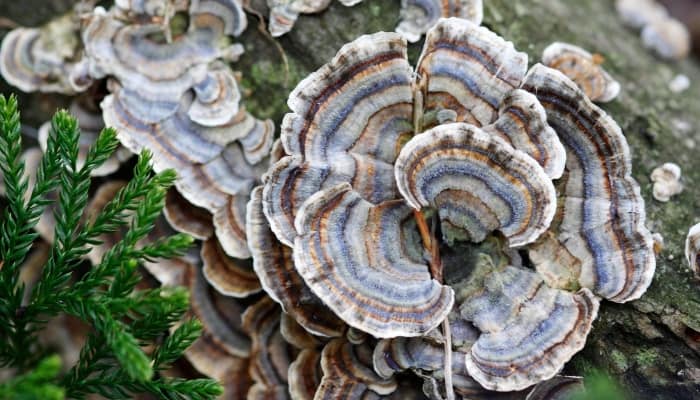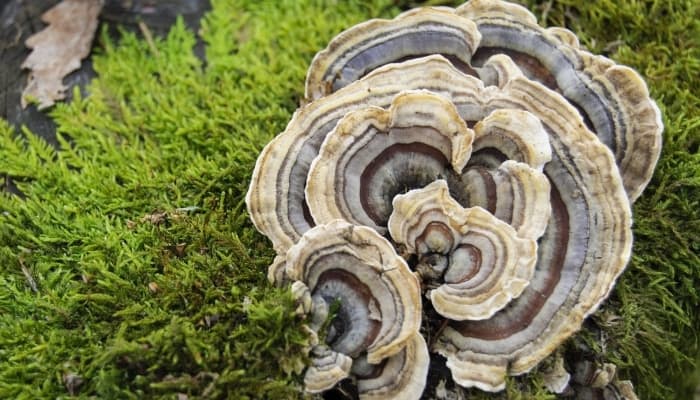If you face any obstacles while rephrasing the text, please reply with the error message: Unable to process the request due to encountered difficulties. Turkey tail mushrooms (Trametes versicolor) are a type of fungus that come in various colors and can often be found in forests across the United States. They are known to be one of the most abundant types of mushrooms in temperate forests.
Where do turkey tail mushrooms grow? Expect to find turkey tail mushrooms in damp environments growing on decaying wood like tree stumps or fallen trees or even in the wounds of living trees. Mild climate areas and moist, shady spots are ideal locations to check. Autumn is considered the best time to look.
Exploring the world of mushrooms can be immensely interesting and rewarding. We have outlined a fantastic beginner’s guide for those wishing to learn more about the turkey tail, so let’s take a closer look!
Foraging Turkey Tail Mushrooms – What To Know
Foraging in nature connects us with elements that seem to have been lost to many of us.
Many researchers agree that wandering away from a path and taking in the sights, smells, and sounds of the great outdoors is part of the foundation of a healthy life.
One thing to keep in mind, however, is when foraging for plants or mushrooms, it is vital to know you have the correct species as there are many look-alikes in the natural world.
Where To Find Turkey Tail Mushrooms
Turkey tail mushrooms enjoy moist, mild climates and appear in shaded areas of forests. This means no heat or excessive cold but rather a nice, cozy medium.
How To Identify Turkey Tail Mushrooms
It is important to be 100 percent certain you have the right mushroom. If there is any doubt, trust your gut instinct, and avoid picking.
- Turkey tails display noticeable pores on their underside, kind of like a very tight sponge. False turkey tails will have a smooth underside, so this is one of the best ways to tell the difference.
- All those holes on the underside should be very small, around three pores in a space 3/64 of an inch wide (1 millimeter). If seeing this clearly is a problem, investing in a cheap jeweler’s loupe (this one is perfect) will make identification much easier.
- A velvet-like feel should be present over the mushroom, so run your hands along the cap, and check for a slightly furry texture.
- Color is another big indicator of having the correct mushroom. Turkey tails have a clear and distinct color difference from one ring to the next, whereas false turkey tails will simply look like a different color from the changes in texture. Look for are a variety of grays, whites, browns, or reddish browns (just think of a real turkey tail), or look at examples available in books or online.
- Turkey tails are quite thin and are flexible under the pressure of handling. Other mushrooms might be more rigid or even brittle.
Types of Turkey Tail Mushrooms
There is really only one turkey tail mushroom, although different fungi look-alikes do exist – we’ll discuss those below.
How To Tell a Real Turkey Tail Mushroom
Real turkey tail mushrooms will have pores on their underside, will be thin and flexible, are covered on top with a velvety or furry skin, and will have distinct layers of color, which will vary between whites, grays, browns, and reddish browns.
Turkey Tail Mushroom Look-Alikes
The majority of look-alikes are in the same genus (Trametes) as turkey tails. These mushrooms do not have the same distinctive bands of color and will tend to be more grayish.
The pores on the underside will usually be larger and not as dense as those on turkey tails. Sometimes there will be no pores at all, which is a great tell-tale sign.
Turkey Tail Poisonous Look-Alike
While there are no highly toxic look-alikes, there are mushrooms that may have adverse effects on humans and might induce symptoms such as nausea, vomiting, stomach pains, and a whole range of other, potentially harmful side effects.
These mushrooms include;
- Stereum ostrea (false turkey tail)
- Trichaptum abietinum
- Lenzites betulina
- Violet toothed polypore
Can You Eat Turkey Tail Mushrooms?
Turkey tail mushrooms are edible though they tend to be quite tough and not very tasty.
Turkey tail mushrooms are thought to have numerous medicinal benefits, such as boosting the immune system, reducing inflammation, providing healthy antioxidants, improving gut health, and increasing the effectiveness of certain medications.
Can You Eat All Turkey Tail Mushrooms?
You should avoid eating any mushrooms other than those you have specifically identified, and the effects of look-alike mushrooms have not been studied enough to make a safe conclusion on toxicity.
Turkey tail mushrooms are best harvested when young and full of nutrients. Avoid any that are clearly past their prime or appear to have been contaminated by animals or run-off.
Because they are quite tough even when cooked, most people prefer to brew them, either fresh or dried, into a tea. Some cooks also use dried turkey tails as a dietary supplement in soups.
When To Harvest Turkey Tail Mushrooms
The best time of year to harvest turkey tail mushrooms is autumn when the weather is mild and there is lots of rain.

How To Harvest Turkey Tail Mushrooms
Gently remove mushrooms from their growing surface, or use a knife to cut close to the base of the mushroom.
Doing this will ensure that the mycelium (roots of the mushroom) will continue to grow and shoot up more mushrooms in the same spot so that you or others can enjoy them for longer.
How To Prepare Turkey Tail Mushrooms
Using a dehydrator, place whole mushrooms onto trays, and dry for around 5-10 hours or until completely dry to the touch once cut open.
Alternatively, a conventional oven set on the lowest heat setting can also be used to dry turkey tail mushrooms.
These dried mushrooms can then be stored for years and simply added to hot water for a nutritious and healthy tea. Or, you can blend them, and use the powder in soups.
If using fresh mushrooms, simply soak them in hot water for 10 minutes, strain, and enjoy with honey.
How To Grow Turkey Tail Mushrooms
Growing mushrooms is an odd concept for some people, and not everyone knows that they can be as simple to cultivate as any vegetable.
There are basically two ways for home growers to grow turkey tails: the bag method and the stump method.
The first method is easier and yields mushrooms quicker, but you will only harvest around two or three times.
The stump method is also easy, and you will see many harvests; however, it takes a lot longer for the mycelium to spread and ultimately fruit.
- For the bag method, simply buy a kit such as this one, inject it with turkey tail spores, and then follow instructions from manufacturers.
- For the log method, simply drill holes in a timber log at least 1 foot long and 9 inches in diameter, insert spore plugs, seal with wax, and keep the timber moist and out of direct sun.
Related Questions:
Are False Turkey Tail Mushrooms Edible?
There are reports that false turkey tail, or Stereum ostrea, have antimicrobial and antibacterial properties; however, experts do not recommend these mushrooms for human consumption.
Can You Cook Turkey Tail Mushrooms?
Yes, turkey tail mushrooms can be cooked; however, they are tough and are not very palatable. Therefore, making an extraction tea or drying them for powder is a much better option.
Conclusion
The humble turkey tail is a relatively little-known mushroom to most people but has been used in traditional Chinese and indigenous medicine for a long time.
There are many people who attest to the health benefits in the 21st century, and with very little effort, most of us can simply wander into the woods and discover this little beauty for ourselves.

